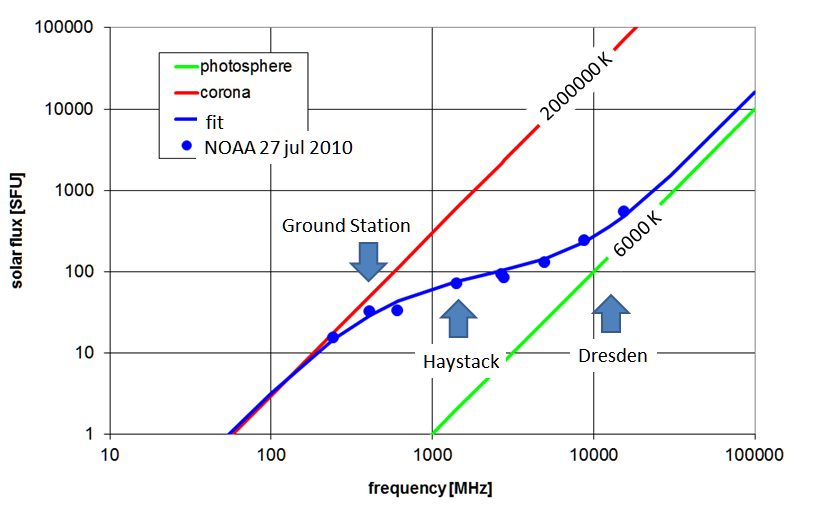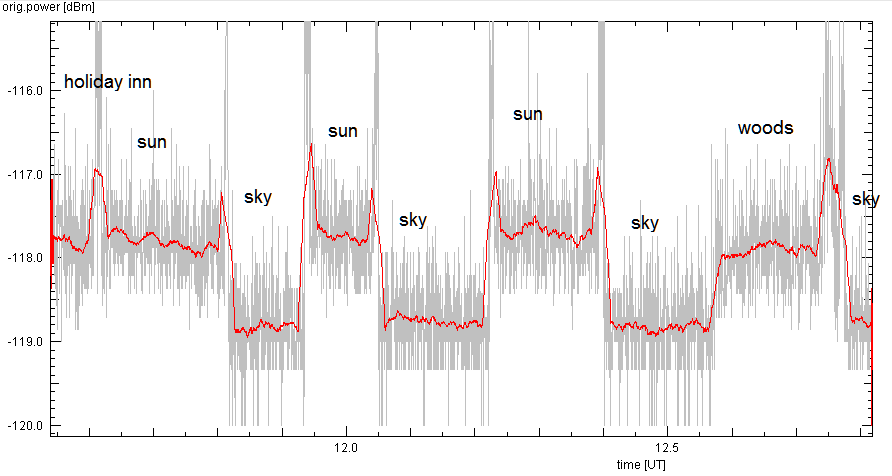How to observe radio emission from the solar corona
Joachim Köppen Strasbourg 2013
The ground station can also be used to observe radio emission from the Sun.
in the signal. While at 432 MHz (indicated by the right hand magenta line)
the station is sensitive enough to pick up
the signal, the solar flux at 144 MHz is too low for our instrument - the
sensitivity corresponds roughly to an antenna with effective diameter of
1 m:
 However, this is not the only constraint: The electronic noise at the Illkirch
site with all the electronics in the building itself as well as all the electronics
present on this campus has become so high that on 20 MHz (RadioJove) we can no
longer observe any radio bursts from the active ("disturbed") sun, on 144 MHz
the sun is undetectable, and on 432 MHz it is just detectable. Above about
1 GHz the Sun is easily observable (with the
ESA-Haystack and ESA-Dresden radio telescopes).
Solar radio fluxes measured every day by a international network of observatories
can be downloaded from
Solar
Indices Bulletin from NOAA. Note that 1 SFU (solar flux unit) corresponds to 10000 Jy:
However, this is not the only constraint: The electronic noise at the Illkirch
site with all the electronics in the building itself as well as all the electronics
present on this campus has become so high that on 20 MHz (RadioJove) we can no
longer observe any radio bursts from the active ("disturbed") sun, on 144 MHz
the sun is undetectable, and on 432 MHz it is just detectable. Above about
1 GHz the Sun is easily observable (with the
ESA-Haystack and ESA-Dresden radio telescopes).
Solar radio fluxes measured every day by a international network of observatories
can be downloaded from
Solar
Indices Bulletin from NOAA. Note that 1 SFU (solar flux unit) corresponds to 10000 Jy:

What do we see from the Sun, depends on the frequency of observation:
Because the solar plasma becomes more transparent at higher frequencies, we
thus can see into deeper layers:
- at optical wavelengths and above about 100 GHz we see the photosphere,
with a temperature of about 6000 K
- at about 10 GHz the ESA-Dresden telescope
looks into the upper part of the Chromosphere (temperature 10000 K)
- at 1.4 GHz the ESA-Haystack telescope
receives emission from the lower part of the solar Corona, with
temperature of about 200000 K
- the Ground Station at 430 MHz picks up radiation from the solar
Corona (temperature 2000000 K). This outer envelope around the sun
is very low density, highly ionized plasma.
- at 144 MHz one could probe the outer parts of the Corona, ...
Thus, observations at various radio frequencies reveal the temperature profile
in the outer atmosphere of the Sun:

We can use the ground station to observe the Sun, simply by pointing manually
the antenna to the Sun (the azimuth and elevation values can be obtained from
the software that controls the ESA-Dresden
telescope). We measure and record the signal strength
in the same way as we do it with satellites ... but when the trace on the
software reached the right hand edge of the screen after several minutes,
we turn the antenna to the left for about 90° but we stay at the same
elevation. We now measure the empty sky, again for several minutes.
Then we move the antenna again to the Sun (but at its current position) ...
and so on: a pretty boring job! But this is necessary to measure the Sun as
well as the sky without the Sun. At the position of the empty sky we measure
the noise background from the receiver, which we need to subtract from the
observations. An example of such an observation sequence is shown below
 This plot shows that the solar signal is only 1 dB above the background
level ... this is less than one should expect from the technical specifications
of the station equipment: one should expect about 5 to 6 dB. The reason is
very simple: the background is not just the noise from the receiver, but it
is the electronic noise pervading the campus!
This plot shows that the solar signal is only 1 dB above the background
level ... this is less than one should expect from the technical specifications
of the station equipment: one should expect about 5 to 6 dB. The reason is
very simple: the background is not just the noise from the receiver, but it
is the electronic noise pervading the campus!
Since the antenna pattern is rather wide (HPBW=28°), it is not possible
to calibrate properly the system by pointing the antenna to a sufficiently
wide building or woods which would constitute a calibration source of known
temperature ...
However, if one works out the signal level from the solar flux measured by
professional stations, the observed level is fully consistent with a coronal
temperature of about 2000000 K!
| Top of the Page
| Back to the MainPage
| to my HomePage
|
last update: July 2013 J.Köppen
